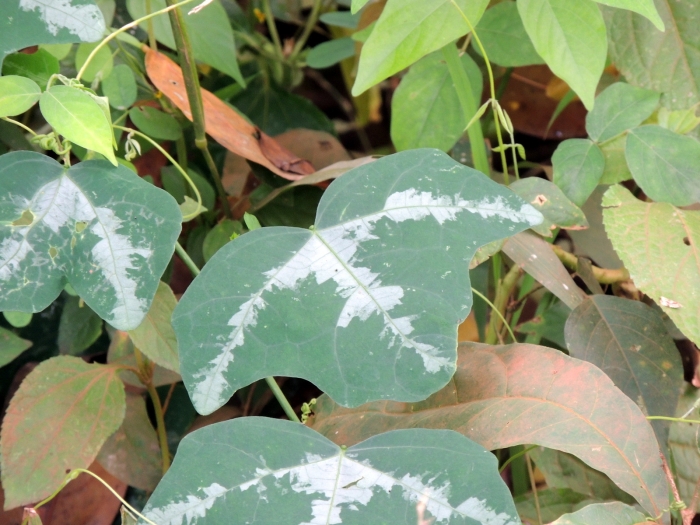Climbing Adenia
(Adenia cissampeloides)
Climbing Adenia (Adenia cissampeloides)
/
/

Vijay Barve
CC BY 4.0
Image By:
Vijay Barve
Recorded By:
Copyright:
CC BY 4.0
Copyright Notice:
Photo by: Vijay Barve | License Type: CC BY 4.0 | License URL: http://creativecommons.org/licenses/by/4.0/ | Rights Holder: Vijay Barve | Publisher: iNaturalist | Date Created: 2019-11-14T10:23:39-08:00 |


Estimated Native Range
Summary
Adenia cissampeloides, commonly known as the climbing adenia, is a perennial woody vine belonging to the passionflower family, Passifloraceae, native to the understory of tropical rainforests and woodland areas in Africa. It is a vigorous climber that can reach lengths of up to 82 feet (25 meters), with pale green to gray-green stems and heart-shaped (cordate) leaves that are distinctive in their appearance. The plant is monoecious, meaning it has both male and female flowers on the same plant. The flowers are small and not particularly showy, with separate male and female blooms that lead to the production of capsules as fruit. In its native habitat, Adenia cissampeloides is adapted to the dappled light of forest floors and the high humidity of tropical climates.
Adenia cissampeloides is valued for its medicinal properties, particularly in traditional African medicine where it is used to treat malaria. The leaves are also edible when cooked and are consumed as a leafy vegetable. In cultivation, it requires a warm, humid environment and can be grown in greenhouses or as a houseplant in temperate regions. It prefers well-draining soil and should be watered regularly but not overwatered. Due to its climbing habit, it may need support structures to grow optimally. While not commonly found in cultivation, it can be an interesting addition to collections of exotic plants.CC BY-SA 4.0
Adenia cissampeloides is valued for its medicinal properties, particularly in traditional African medicine where it is used to treat malaria. The leaves are also edible when cooked and are consumed as a leafy vegetable. In cultivation, it requires a warm, humid environment and can be grown in greenhouses or as a houseplant in temperate regions. It prefers well-draining soil and should be watered regularly but not overwatered. Due to its climbing habit, it may need support structures to grow optimally. While not commonly found in cultivation, it can be an interesting addition to collections of exotic plants.CC BY-SA 4.0
Plant Description
- Plant Type: Vine
- Height: 10-20 feet
- Width: 5-10 feet
- Growth Rate: Moderate
- Flower Color: Green, White
- Flowering Season: Summer
- Leaf Retention: Deciduous
Growth Requirements
- Sun: Full Sun, Part Shade
- Water: Medium
- Drainage: Medium, Fast
Common Uses
Low Maintenance, Potted Plant
Natural Habitat
Native to the understory of tropical rainforests and woodland areas in Africa
Other Names
Common Names: Rope Vine, Bele, Bolondola, Bolondola Moke, Diladiambiyi, Dondalo, Climbing Adenia, Dondolo
Scientific Names: , Adenia cissampeloides, Adenia adenifera, Adenia adenifera, Adenia gracilis, Adenia gracilis subsp. pinnata, Adenia gracilis subsp. pinnata, Adenia guineensis, Adenia guineensis, Adenia gummifera
GBIF Accepted Name: